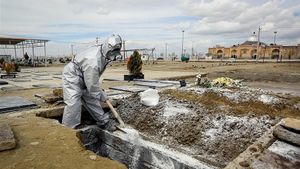The Way The Government Is Chasing After The Worst Scenario Will Never Be Enough To Deal With COVID-19

JAKARTA - The government claims to have prepared the worst strategy if positive cases of COVID-19 penetrate up to 100 thousand per day. However, experts consider this not enough because what must be done, namely strengthening testing, tracing, treatment, or 3T to deal with this pandemic has not been carried out.
The Coordinating Minister for Maritime Affairs and Investment who is also the Coordinator of Emergency PPKM Luhut Binsar Pandjaitan revealed that his party had prepared a worst-case scenario if the number of COVID-19 cases penetrated 100,000 per day.
This was conveyed after COVID-19 cases reached nearly 50 thousand and even reached 50 thousand more on Thursday, July 14.
Seeing this condition, an epidemiologist from Australia's Griffith University, Dicky Budiman, assessed that the current government is only taking curative actions, which actually makes the handling of the COVID-19 pandemic worse.
"In responding to the crisis situation (currently, ed) what must be improved is 3T because testing, tracing followed by self-isolation and quarantine will reduce the burden," said Dicky to VOI, Friday, July 16.
"Remember, don't get hung up on curative things because there will never be enough, it will be really big (additions, ed)," he added.
He said testing in Indonesia should start to increase to 1.5 million per day. Because, with the implementation of the 3T, the number of COVID-19 cases could decrease by half or even more, especially now that strict restrictions have been put in place by the government.
The government, continued Dicky, should be able to learn from India when it comes to handling the massive spread of COVID-19 due to the Delta variant by increasing the number of their tests to find new cases.
"When testing (in India, ed) increased from 1.5 million to 9 million so that more cases were found and quarantine was carried out, the need for beds, ICUs, and ventilators decreased," he said.
SEE ALSO:
So, increasing 3T should be homework that must be done by the government. Because we continue to chase to prepare facilities with COVID-19 cases that continue to increase due to faster transmission, it will not be enough.
Moreover, the addition of facilities including making an emergency hospital to handle COVID-19 will actually cause a new problem, namely human resources (HR). "Because adding is not just an addition, but we have to think about the human resources, the facilities, then there are other supporting facilities. This can't be overtaken," said Dicky.
Epidemiologists do not deny that the improvement of health facilities is necessary. However, Dicky also mentioned how currently the health workers are tired but still have to be asked to work more in emergency hospitals.
"I didn't mention the hospital, but someone complained to me, 'Doc, this is making an emergency hospital, but the human resources are asked to us again. What's going on,'" said Dicky.
For this reason, he then asked the government to work quickly to implement 3T massively as a preventive measure. This includes accelerating the delivery of the COVID-19 vaccine.
"A preventive public health strategy to find cases quickly and in detail at the source? How do you do it 3T, tracing, treatment, and then self-isolation," he said.
Previously, Luhut said there were a number of strategies that the government had prepared to deal with 100,000 COVID-19 cases, such as preparing hospitals to recruit medical personnel, namely nurses and doctors who had just finished their education.
Currently, he said, there are more than 20 thousand nurses who will soon be trained and hired. Meanwhile, as many as 2,000 newly graduated doctors have been recruited to be immediately trained and mobilized.
Not only that, the government also supplies free medicines for COVID-19 patients with mild symptoms and people without symptoms (OTG). The drug packages have been distributed to the public as of Thursday, July 15. In detail, the distribution of the package as much as 10 percent is allocated to packages for people without symptoms (OTG).
Then, as much as 60 percent for the package of symptoms of fever and anosmia. While the remaining 30 percent are packages for mild symptoms of fever and cough.
In addition, Luhut also said that the government was bringing in medicines from various countries.
"All of this data is on the right track. There are several drugs that are flown in from various countries. Tocilizumab is very expensive but it is already in the process, as well as Remdesivir has also been imported," explained Luhut in a virtual press conference, Thursday, July 15.

